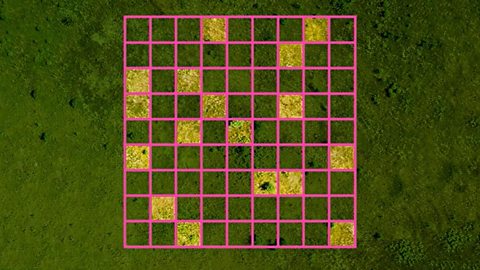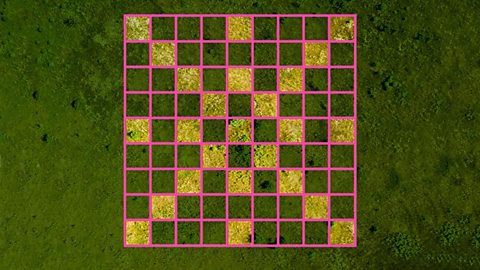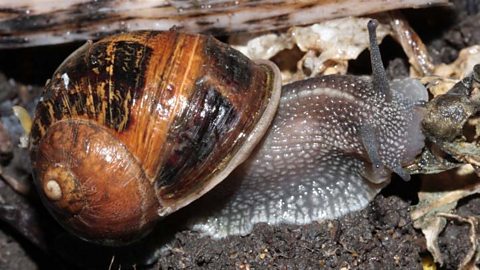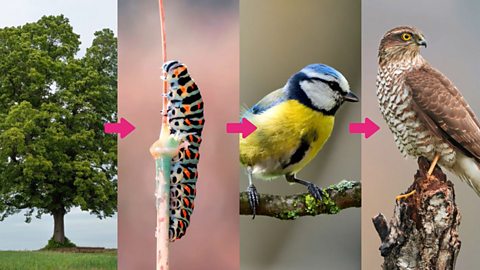Key points
Sampling is a type of scientific surveying which can save time and money and give information on the population of animals and plants.
There are many different types of sampling; the most useful type depends on the habitat and what is being sampled.
Video
If you want to know if a cake is good, you could just try a sample.
In ecology, sampling can help us estimate the number of a species in an area without having to count each one. So if there are 10 daisies in one quarter of the garden, we can estimate the whole garden has 40.
To start you map an area and divide it into a grid. With systematic sampling you can then select the points to monitor but this can introduce bias. Random sampling eliminates bias by generating the points randomly.
Now you need sampling tools. For example, you could use a pooter jar, a pitfall trap or a sweep net or to count plants or slow moving animals, you could use a one metre by one metre square frame called a quadrat, place it at the sampling points and then you can count the number of organisms of one species or the number of different species.
Whatever the method, respect the species you're studying by leaving everything the way you found it, unless you're studying cake, then you don't need to leave any.
Can you answer these questions based on the video?
1. What helps scientists estimate the number of species in an area?
2. What is a square frame used in sampling called?
Sampling
A quadrat
Why sampling is important
To find out how many polar bears there are in the Arctic, they could all be counted individually. However, it would take a long time and the chances of actually finding them all would be quite small. To make this process easier scientists look at a smaller part of the populationAll the members of a single species that live in a habitat. or its habitatThe place where an organism lives. to draw conclusions about the whole area. This type of scientific surveying is called samplingGathering a small amount of data when it is not possible to measure everything.. Obtaining an estimate by sampling is faster, less expensive and, in most cases, gives us all of the information we need.
There are lots of different methods of sampling, but they all involve investigating living organisms in one or more habitats. This information is extremely important. It is the first step in working out which species are nearing extinct A species that no longer exists. . Because of this, sampling is essential for conservationThe process that preserves and protects organisms and their habitats and so maintains biodiversity..
It is essential that any sampling does not affect the living things or their habitat.

Quadrats
A quadratA square frame used in ecological sampling for plants and slow-moving animals. is a square frame which is used in sampling. It is placed in a location and the plants or slow-moving animals inside it are counted.
The following things can be counted within a quadrat:
- The number of a single species.
- The number of different species - a measure of biodiversityA measure of the range of living organisms within a habitat..
- The percentage of the quadrat taken up by one species - it is much easier to do this than count all the individual blades of grass, for example.

Random sampling using quadrats

When counting the number of a single species in a habitat, if the proportion of the habitat you have sampled is known, the total number of that species in that habitat can be estimated. For example, if you counted 43 dandelions on 25% of the school field then you could estimate the whole field by multiplying 43 by four to make 172.
25% = 43
100% (43 × 4) = 172
Most sampling using quadrats is random. This means it has the same chance of being placed in any position within the habitat. You cannot close your eyes, turn around a few times and throw your quadrat. This might seem random but it canÔÇÖt ever land at your feet or beyond your throw, so it isnÔÇÖt. Sampling also shouldn't harm any species - it is important to leave everything as you found it.
Sampling must not be biasA preference for or against an idea or data being affected by errors in method or equipment. - for instance, choosing to sample where there are lots of plants. Here is an example of a way sampling could be undertaken without bias.
- When you have chosen a sampling area, first divide it up into a grid, for instance, having 10 × 10 divisions.
- Use a suitable method to generate a pair of random coordinatesNumbers used to indicate the position of a point. on your grid. For example, you could draw numbers out of a hat.
- Place the first quadrat on your grid using these coordinates.
- Count and record the number of each species within this quadrat.
- Repeat steps 1-4 so that you have a total of at least 10 counts. This will give you more data, which will make the results more accurate.

Systematic sampling using quadrats

Sometimes scientists want to link the number of organisms they are sampling to an environmental factor. For example: 'are more snails found nearer the edges of the lake?' Random sampling would give an estimate of the total number but not show where they are in relation to the lake.


In this case systematicIn ecology, systematic sampling follows a regular and not random pattern. sampling would be used instead. This is not random. An imaginary line called a transectAn imaginary line used in systematic sampling. is drawn from one part of the habitat to another. The quadrat is placed at regular distances along this line and the species counted as before. The environmental factor that is being investigated is measured at each quadrat position. The link between the organisms and the factor can then be seen.

Other equipment used for sampling

Image caption, Pooter
Pooters are small devices using to suck up small animals like ants.
Image caption, Pitfall trap
A pitfall trap is dug into the ground and a small sample of food placed inside to attract small animals.
Image caption, Net
Sweep nets are swept through long grass to catch insects. Nets are also used in kick sampling, in which a foot is used to disturb the stones or sediment of a river or stream and a net collects the sample downstream.
1 of 3
Test your knowledge
Quiz
Test questions
Can you remember the steps in systematic sampling with a quadrat? Tap Show more to see the answer.
- Draw an imaginary line called a transect from one part of the habitat to another.
- Place the quadrat at regular intervals along the transect.
- Count the number of one species, the number of species or percentage cover of one species and record the result.
- Measure and record the environmental factor at each position.
Play the Atomic Labs game! gamePlay the Atomic Labs game!
Try out practical experiments in this KS3 science game.

More on Ecosystems and habitats
Find out more by working through a topic
- count4 of 7

- count5 of 7

- count6 of 7

- count7 of 7
